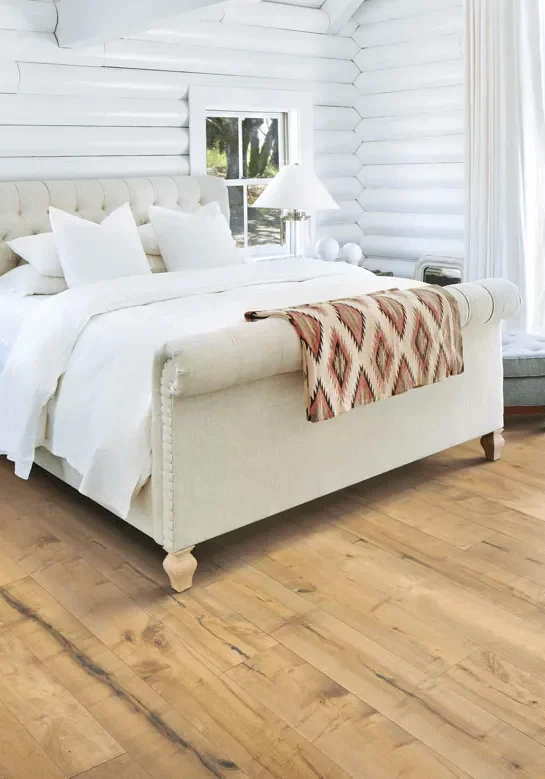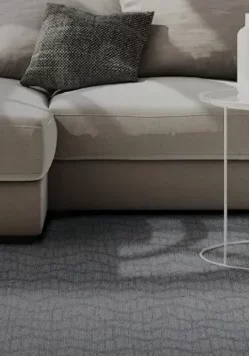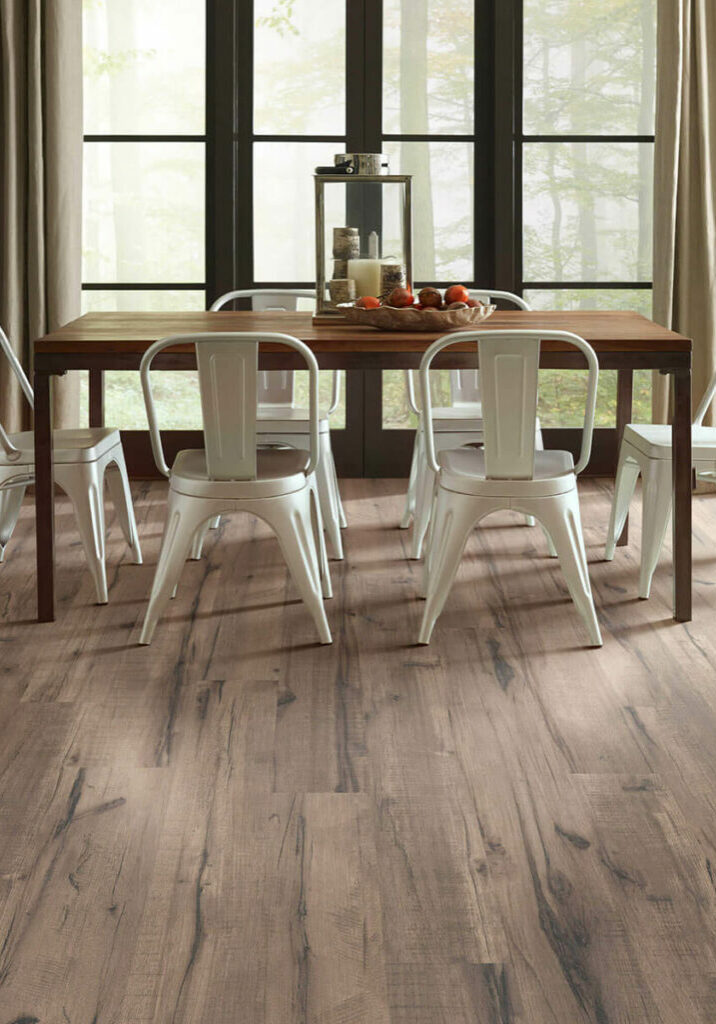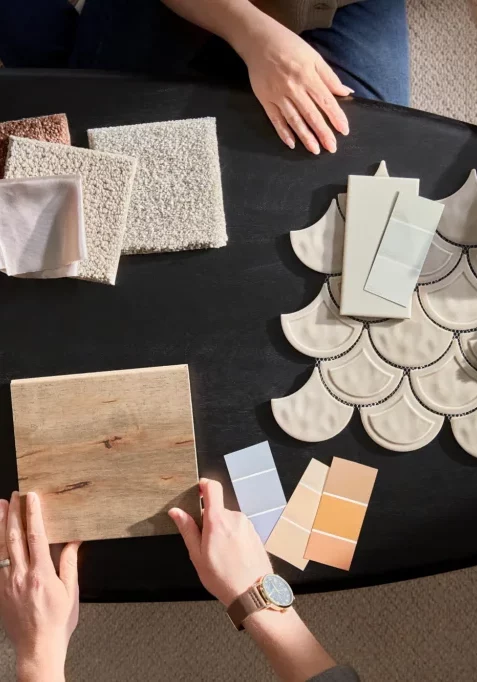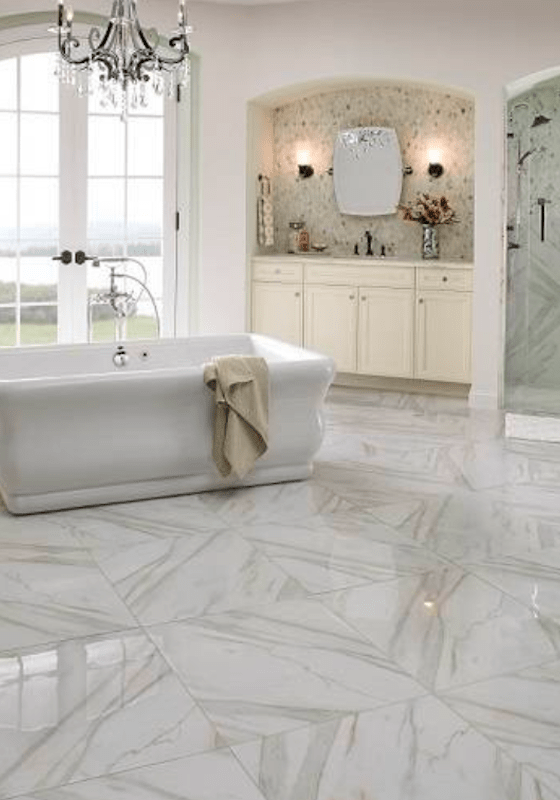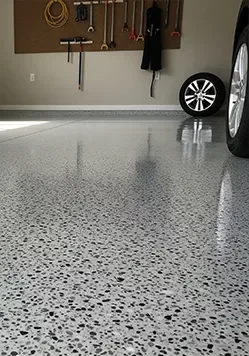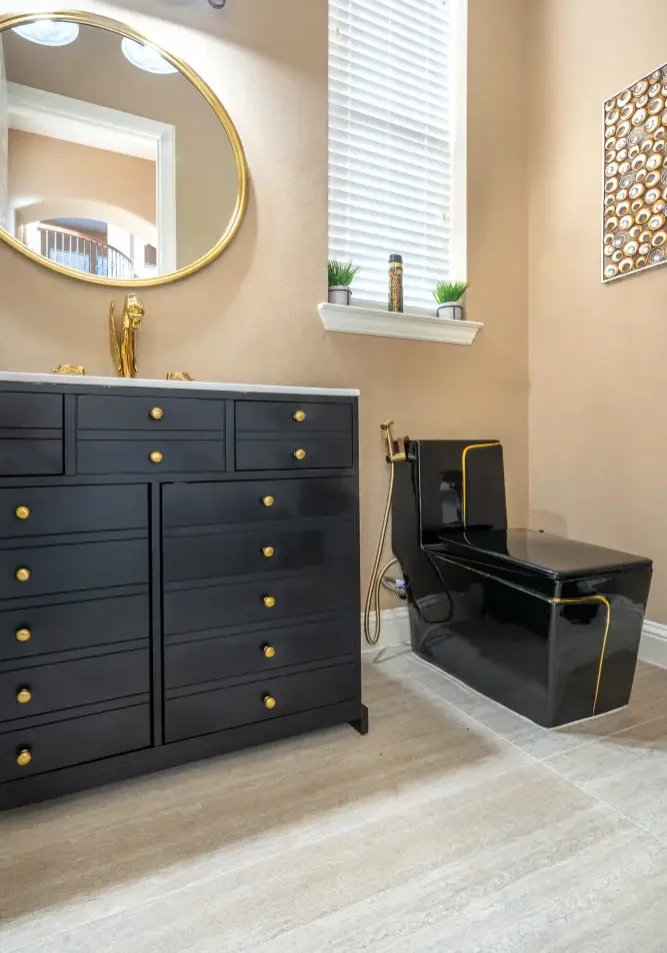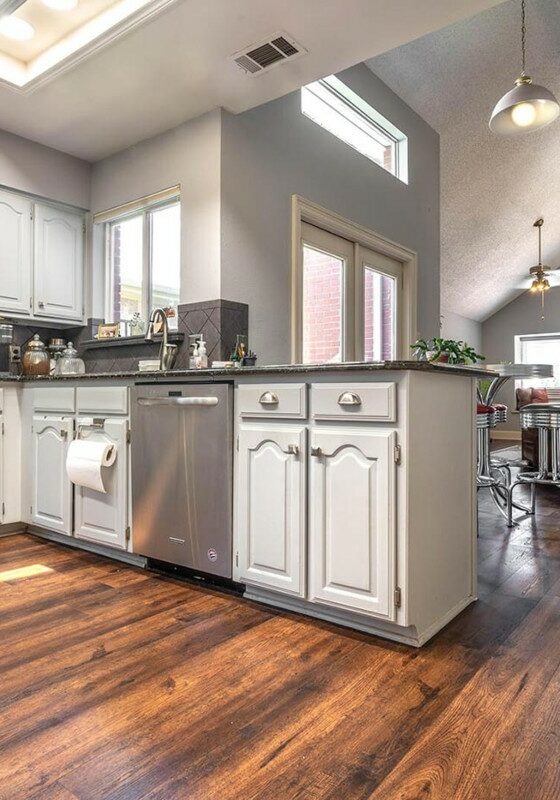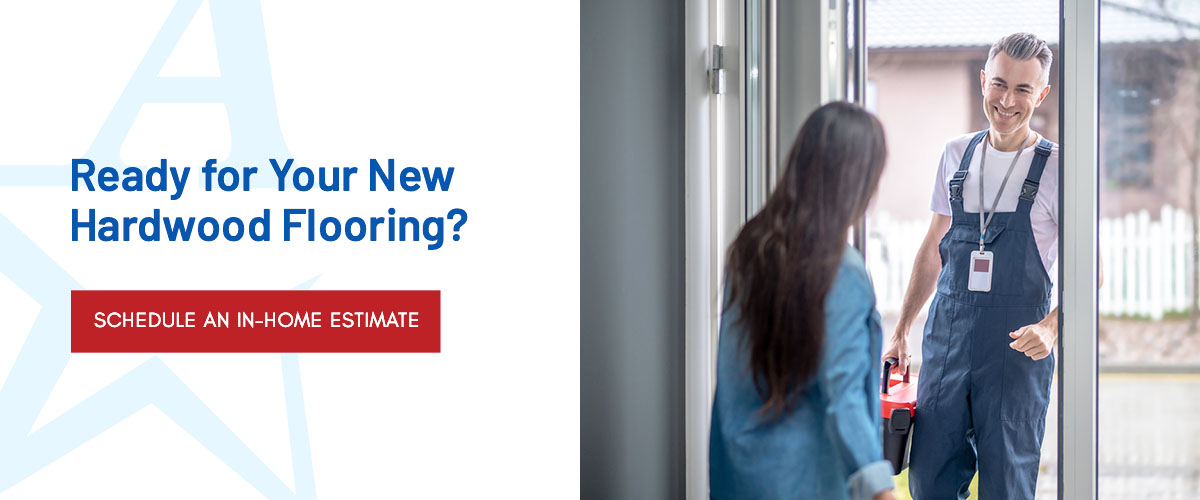How to Select Hardwood Flooring for Your Home
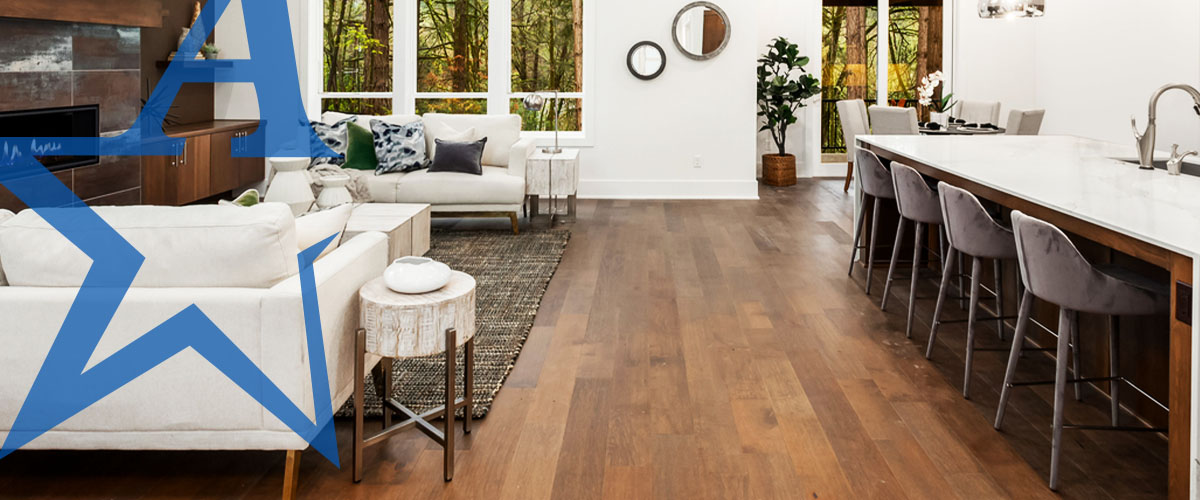
With the many flooring types on the market, deciding what to buy can be overwhelming. Hardwood flooring is popular among American homeowners for its strength and natural style. Ideal for high-traffic areas, it is resistant to damage and easy to maintain. Choose from a dazzling array of hardwood floor options to match any style, taste, and area.
Qualities that influence your decision include color, budget, and wood species. The room environment and foot traffic where you install the flooring matter. Harwood floors are an investment. Here are 10 factors to consider before you buy.
1. Engineered vs. Solid Hardwood Flooring
Whether you want to buy solid or engineered hardwood flooring depends on the room where you’ll install it. Engineered hardwood floors suit moisture-prone rooms, like a basement or kitchen, while solid hardwood is ideal for busy areas like living rooms.
Solid Hardwood Flooring
Solid hardwood is a single layer of wood cut to the preferred size. You can customize the wood with stains and finishes. Depending on its thickness, it can be pre-finished multiple times, making it more durable than engineered hardwood. There are three types of solid hardwood floors:
- Strip: Narrow pieces less than 3 inches wide. It is cheaper but less dense than plank hardwoods.
- Plank: The widths vary and are available in ½ or ¾ thickness.
- Parquet: Individual pieces join to create decorative geometric patterns.
Engineered Hardwood Flooring
Engineered hardwood consists of multiple folded layers. The inner layers form a core topped by natural wood. This option works in areas unsuitable for solid hardwood, such as basements. With its thin upper layer, you can refinish engineered flooring once or twice over its lifetime.
2. Hardwood Species
The species of wood you choose affects more than aesthetics. Differences in hardness and grain offer certain benefits. You can choose between domestic or exotic woods.
Domestic Woods
Some examples of American wood species include:
- Hickory: The grain absorbs stains well, giving it more color range than other woods. It is also one of the hardest woods, making it shock-resistant.
- Mahogany: Its rich tone and longevity make mahogany a popular, albeit pricier choice.
- Maple: This warm, light-grain wood works well in high-traffic areas.
- Oak: Oak is a durable, easy-to-find wood with an appealing grain.
Exotic Woods
Other wood species come from around the globe, such as:
- Brazilian cherry: The distinctive hues make it a bold choice that may not suit every taste or room.
- Ipe: Another Brazilian wood, the contrasting tones give this species visual appeal. Its durability makes it a good choice for decking.
- Kempas: Hailing from Southeast Asia, kempas’ appearance resembles mahogany with reddish-brown hues. This wood’s density makes it suitable for high-use areas.
3. Wood Hardness
The harder a wood is, the better it resists denting and wear. Busy rooms with high foot traffic require harder wood types. Softer flooring works well in low-activity rooms. The Janka wood hardness scale measures certain qualities to determine durability. The scale compares other species against red oak, the wood industry standard. Floors made from red oak can last up to 10 decades.
4. Hardwood Floor Finishes
Your floor’s chosen finish impacts maintenance and cleaning. You can choose between pre-finished or unfinished floors:
- Pre-finished: Pre-finished floors are factory-finished with sanding, staining, and coating. They arrive ready-to-install, making them convenient for homeowners who want minimal downtime. Floors with this finish have a manufacturer’s lifetime guarantee.
- Unfinished (site finished): Contractors sand, stain, and coat these floors on-site. Unfinished flooring gives you more customization options but takes longer to complete. Expect a time delay before moving into the home or using the room.
When deciding between pre-finished and unfinished floors, here are some factors to consider:
Application
Pre-finished floors undergo a preservation process in the factory. Most manufacturers sand, stain, and coat them with polyurethane. The boards may be oven-baked, a process that creates a harder finish. The beveled edges on pre-finished boards can make the floor uneven after installation.
Unfinished wood has no lines between the boards, making the floor flat and smooth. However, finishing the floor at the jobsite means more mess and chemical exposure.
Appearance
Site-finished wood looks more natural and warmer than pre-finished wood. There are more stain customization options. With pre-finished flooring, you choose from what is available in-store. The grain on pre-finished wood is less conspicuous.
Cost
The initial cost of buying pre-finished flooring is higher than unfinished hardwood. The latter becomes more expensive once you add sanding, staining, and coating. When added up, the overall cost of pre-finished floors is usually less than that of unfinished hardwood floors.
5. Grain Pattern
Wood grain patterns differ depending on the species and cut. Common grain patterns include:
- Flat: Woodcutters cut the tree trunk at a right angle to create a uniform pattern that suits elegant tastes.
- Curly: Trees like maple and walnut sometimes form “twisted” grain patterns.
- Straight: The pattern on straight grains is similar to flat. Straight-grained planks are more durable because they’re cut from the center.
- Interlocked: In some trees, grains alternate between right and left. This causes a ribbon-like pattern.
- Irregular: Due to abnormalities in the tree, irregular grains twist and spiral.
6. Wood Textures
Hardwood’s different textures add to the look of the floor. Three standard textures include:
- Smooth: A popular choice due to its flat surface. The smooth texture comes from sanding boards down to an even thickness.
- Distressed: For a reclaimed look, choose distressed wood. Artisans create the texture using techniques to bring out the wood’s natural features. It works well in homes with a rustic feel.
- Wire-brushed: This method creates a unique grain while revealing the plank’s inner beauty. This texture works well to mask scratches or imperfections.
- Handscraped: Artisans dishevel the wood’s surface with tools for an antique look. This low-maintenance texture suits homes with a vintage style.
7. Plank Specifications
Hardwood floor planks come in various lengths, widths, and thicknesses. Wide planks are easier to install than narrow strips. Most wide planks are denser, made from the tree’s heartwood, and may be more sturdy than narrower pieces.
The thickness of a floor determines its wear layer, the top surface exposed to foot traffic. The thicker the wear layer, the more durable the floor. Buy hardwood floors with a wear layer over 3/16 inches thick.
A thick wear layer provides more opportunities for sanding and pre-finishing. Although thick hardwood flooring has more upfront costs, it has a longer life span.
8. Reclaimed or Salvaged Wood
As a natural resource, wood is an eco-friendly flooring material. Trees take hundreds of years to mature and regrow, so reclaiming is a more sustainable option. Reclaimed wood recycles existing materials from old homes, abandoned structures, and commercial buildings. The wood is then shaped into flooring materials.
Salvaged wood is where the tree is still in its natural state. It may have fallen in a storm or due to construction. Using salvaged wood creates flooring without felling a growing tree.
9. Natural vs. Stained
Wood species vary in color. Many leave hardwood in its natural state because of the appealing hues and grains. You should only consider staining hardwood when you prefer an unnatural color. Stains change the wood’s color and make the grain patterns more apparent. Different hardwood species react to stains in unique ways, so it’s best to hire a professional. Hardwood comes in the following shade options:
- Light: Light-colored wood works in darker rooms with few windows. It can brighten a space and make it appear larger. Lighter woods, like pine and white oak, hide imperfections.
- Dark: Dark woods, such as mahogany and walnut, are ideal in a well-lit room with many windows. They provide a bold look, but scratches are more noticeable.
- Medium: Medium woods, such as cherry or red oak, strike a balance between light and dark. These woods give the distinct look of dark but better mask blemishes.
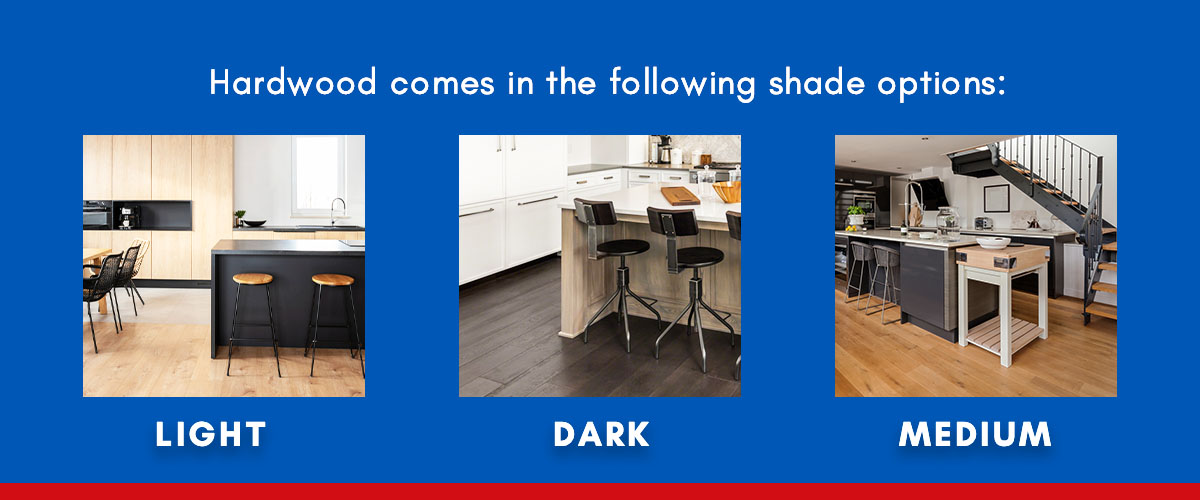
10. Installation Methods
When buying hardwood flooring for your home, choose between floating or fixed floors:
- Fixed floor (Can be either glue-down or nailed): This method bonds the top floor to the subfloor or damp-proof membrane. Unlike floating floors, it is a permanent fixture. Installing fixed floors requires specialized tools and techniques, so a professional should do it.
- Floating floor: Popular with DIY enthusiasts, this involves “floating” the hardwood on top of the subfloor. Think of it like a rug or a jigsaw puzzle. You stick individual planks together, and the collective weight holds them to the floor. This is a common way of installing laminate flooring, but it can work on engineered hardwood. The sublayer or substrate must be flat before placing the floating floor.
Ready for Your New Hardwood Flooring?
With decades of experience and a large variety of finishes and styles to choose from, All American Flooring is here to bring your vision to life. Schedule an in-home estimate today!


